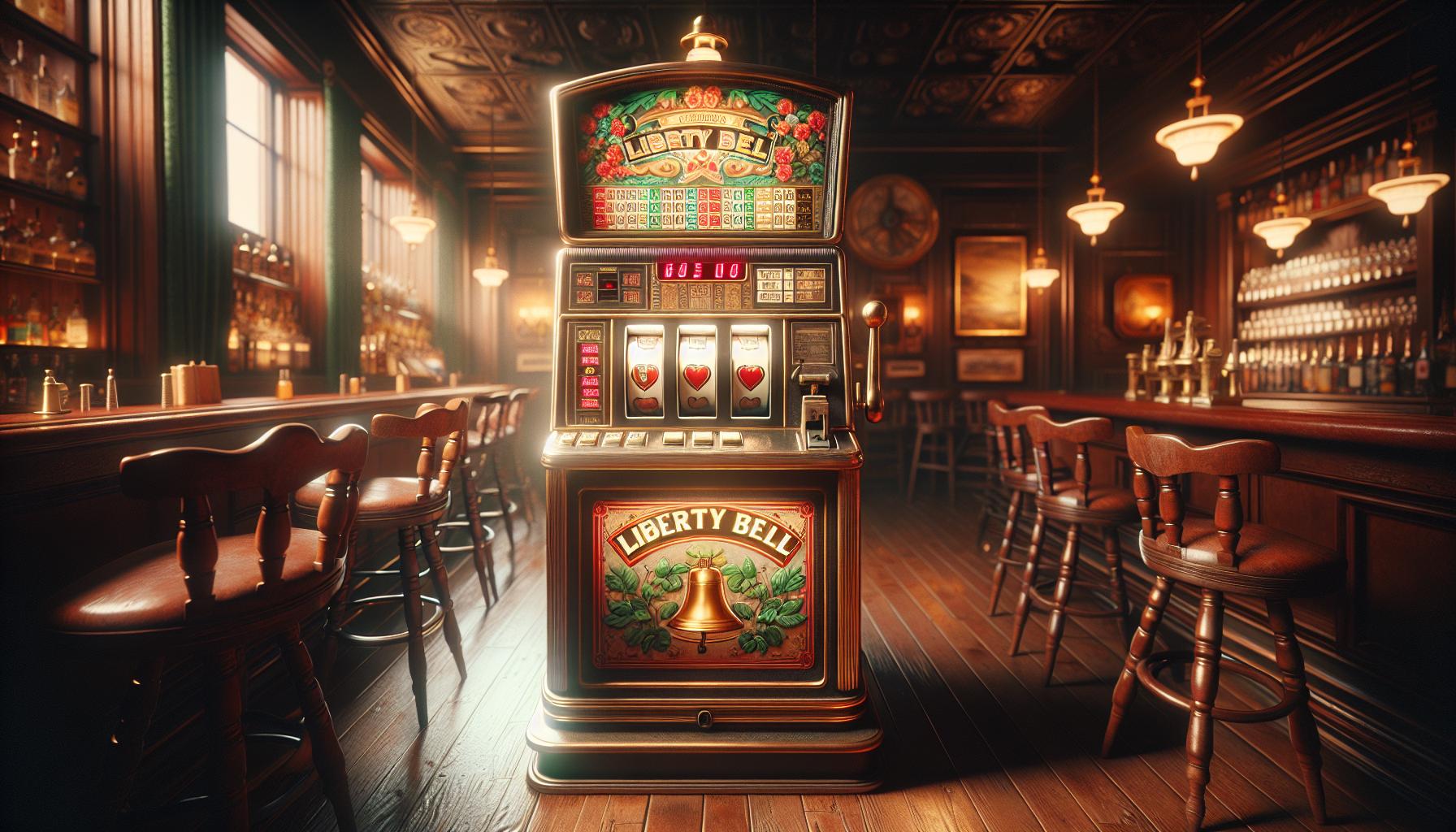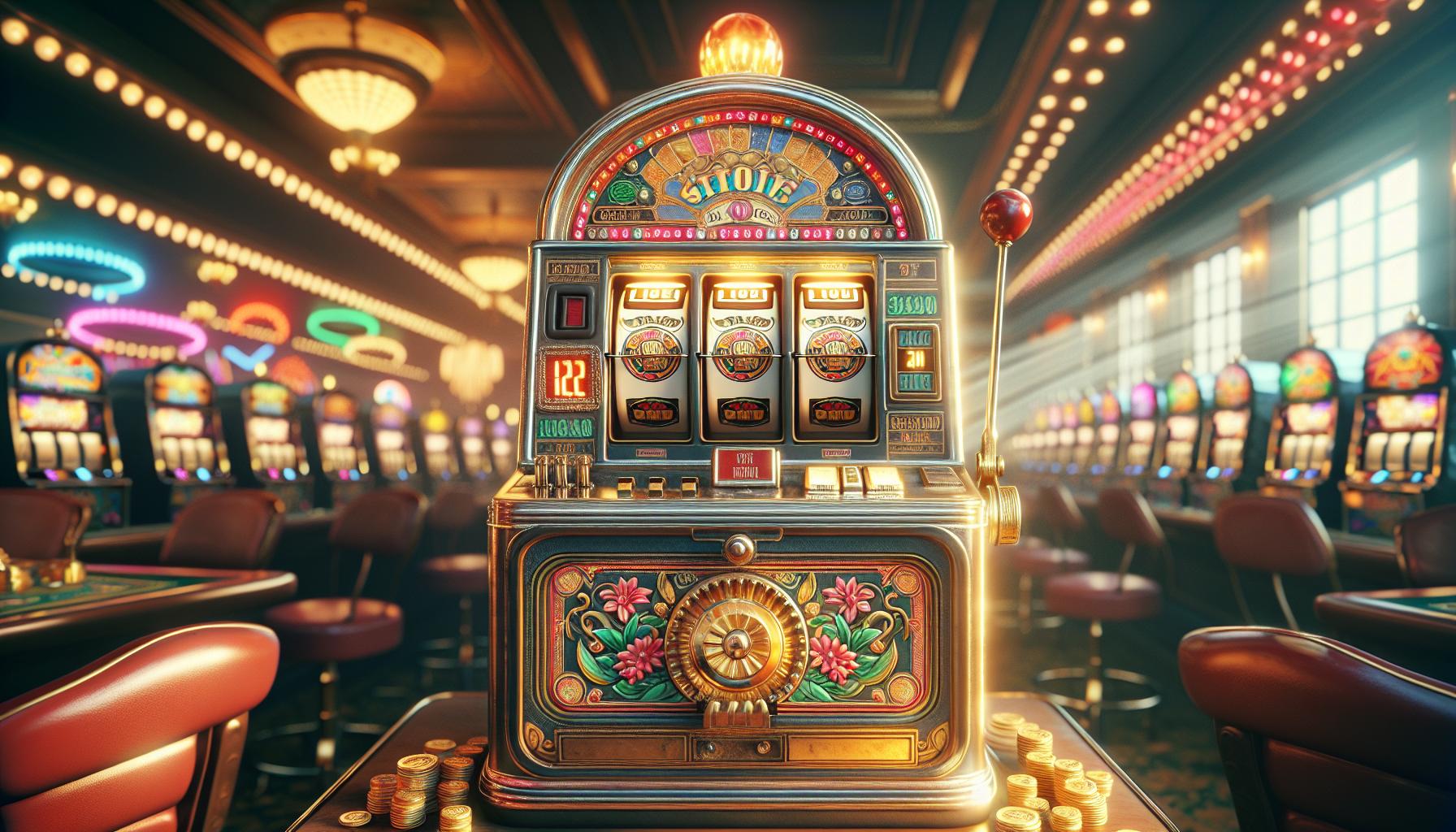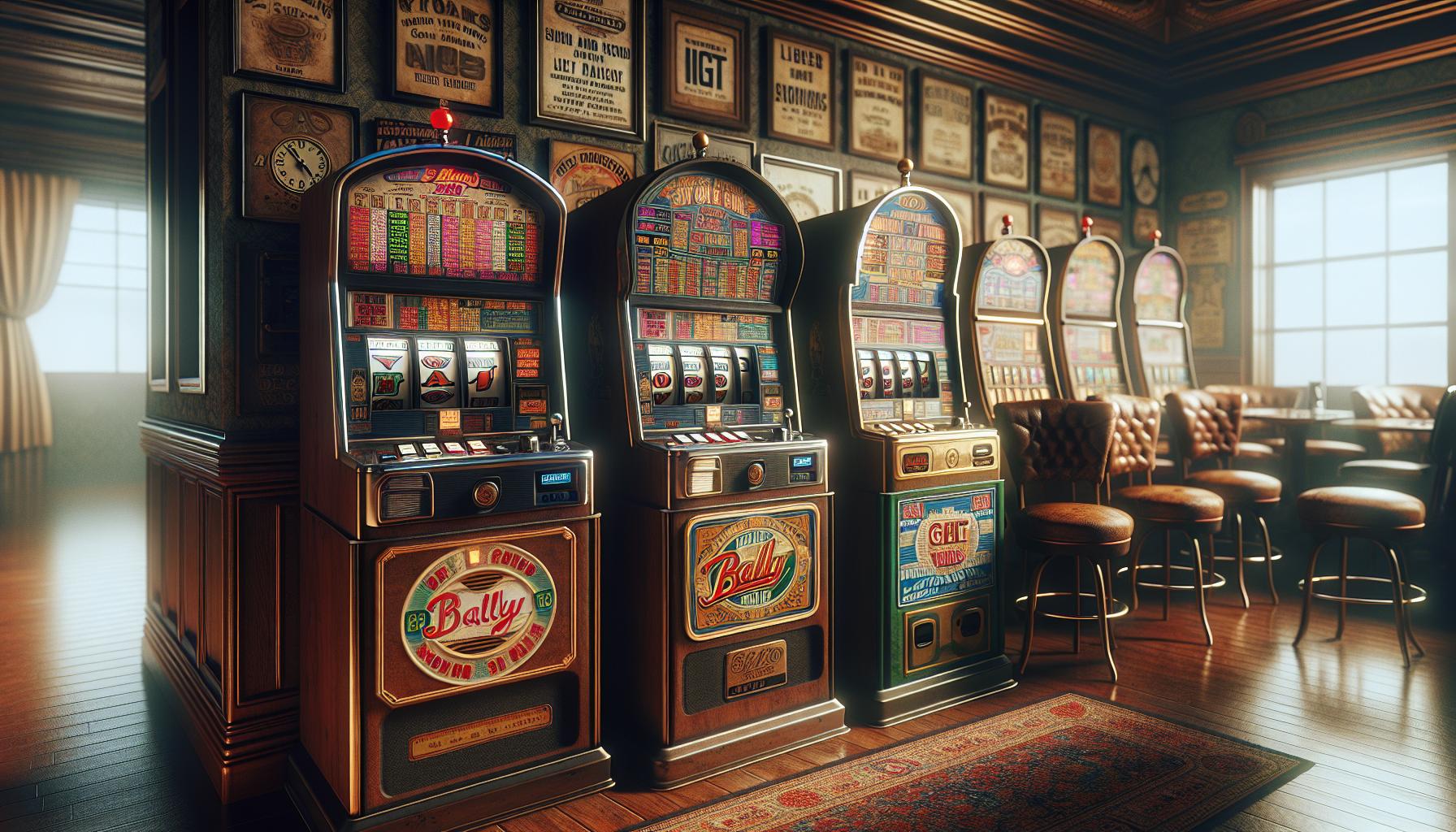There’s something undeniably charming about old slot machines. These vintage beauties, often adorned with bright colors and intricate designs, tell stories of a bygone era when gaming was simpler yet filled with excitement. I’ve always been fascinated by how these machines evolved from mechanical wonders to the digital marvels we see today.
As I delve into the world of old slot machines, I can’t help but appreciate their unique appeal. They evoke nostalgia and remind us of the thrill that comes with pulling a lever and watching the reels spin. Join me as we explore the history, mechanics, and cultural significance of these classic gaming devices that continue to capture the hearts of many.
Key Takeaways
- Old slot machines, dating back to the late 19th century, are a unique blend of mechanical innovation and nostalgic charm, marking the evolution of gaming from simple mechanisms to digital technology.
- The Liberty Bell, created by Charles Fey, is recognized as the first successful slot machine, paving the way for future designs and contributing to the development of the gaming industry.
- These vintage machines are celebrated for their intricate artwork, robust materials, and immersive sound effects, making them prized collectibles for enthusiasts and reflecting their cultural significance in social settings.
- Collecting old slot machines has gained popularity, with enthusiasts exploring various venues such as auctions and antique stores to find rare models, emphasizing the importance of authenticity, condition, and restoration.
- The cultural impact of old slot machines is evident in their representation in films, art, and gaming conventions, maintaining their relevance in contemporary society and showcasing their nostalgic appeal.
- Modern slot machines continue to be influenced by the designs and mechanics of vintage models, ensuring that the legacy of old slot machines persists in today’s gaming landscape.
Old Slot Machines
Old slot machines offer a unique glimpse into the history of gaming, showcasing mechanical ingenuity and aesthetic design. These vintage devices emerged in the late 19th century, with the Liberty Bell, created by Charles Fey in 1895, being one of the first successful models. This three-reel machine featured symbols like horseshoes and playing cards, setting the foundation for future designs.
Mechanics played a critical role in their operation. Early machines used a simple lever to activate spinning reels, with a random outcome determined by a variety of mechanical components. Players pulled the lever and watched the reels spin, hoping for a winning combination. The thrill of anticipation defined the experience long before digital slots dominated the market.
Cultural significance remains noteworthy. Old slot machines became symbols of casinos in the mid-20th century, often associated with glamour and excitement. They not only entertained but also reflected societal trends and values of their time. Many enthusiasts appreciate the craftsmanship and artistry of these machines, as each piece often featured intricate designs and vibrant colors.
Collecting old slot machines has surged in popularity. Hobbyists seek rare models and appreciate their historical context. Some machines can fetch thousands of dollars at auctions, appealing to collectors and gaming history enthusiasts alike. The nostalgia they evoke attracts many who cherish the simplicity of past gaming experiences.
In addition to their collector’s appeal, old slot machines continue to influence modern gaming. Their designs inspire contemporary slots, blending retro aesthetics with advanced technology. The legacy of these classic devices ensures they remain relevant, enriching the gaming landscape for new generations.
History Of Slot Machines

Slot machines boast a rich history that reflects the evolution of gaming technology and culture. These devices transformed from simple mechanical tools to complex digital entertainment systems, captivating players for over a century.
Early Beginnings
The journey of slot machines began in the late 19th century. In 1887, a device called the “Liberty Bell,” designed by Charles Fey in San Francisco, introduced the world to the first successful automatic payout machine. This innovative machine featured three spinning reels and five symbols: horseshoes, diamonds, spades, and the iconic Liberty Bell. Players won prizes by aligning matching symbols, creating a thrilling experience. By the early 1900s, these machines gained immense popularity in bars and saloons, offering a simple way to attract customers and boost profits.
Evolution Through The Years
Throughout the 20th century, slot machines underwent significant transformations. In the 1930s, manufacturers introduced electro-mechanical devices, enhancing gameplay with lights, sounds, and advanced mechanisms. One prominent example is the “Ballyhoo,” developed by Bally Manufacturing in 1931. This machine featured a coin hopper, allowing for more attractive payouts.
The 1960s marked the introduction of video slot machines, utilizing cathode-ray tubes to display visuals. IGT’s “Money Honey,” released in 1987, revolutionized the industry by offering a progressive jackpot, enticing players with increasing payouts. The rise of the internet in the late 1990s further reshaped the landscape, leading to the creation of online slot machines that mimic classic designs while providing instant access to a wider audience.
Today, old slot machines continue to influence modern gaming, characterized by nostalgia for their unique design elements and mechanical heritage. Collectors actively seek vintage models, ensuring these iconic devices remain part of the gaming narrative, bridging generations of enthusiasts.
Mechanics Of Old Slot Machines

Old slot machines rely on mechanical components to create an engaging gaming experience. Their internal mechanisms and design features contribute significantly to their nostalgic appeal.
Internal Mechanisms
Gold-plated gears, levers, and springs comprise the internal mechanisms of old slot machines. These components interact to produce the iconic spinning reels and the sound of coins clinking.
- Reels: Three or more spinning reels display symbols. Each reel’s stopping position determines the player’s payout.
- Lever: The pull lever activates the reels, instilling excitement and anticipation. This mechanical action creates a tactile experience.
- Payout System: The payout system includes a coin hopper. It releases coins when a winning combination appears, rewarding players immediately.
- Randomness Mechanism: The use of physical mechanics ensures randomness. The stopping patterns of the reels hinge on the weight and placement of symbols, offering varying outcomes.
Design Features
The design of old slot machines captivates with its visual appeal and retro charm. Distinct features enhance their attractiveness.
- Artwork: Colorful graphics and thematic illustrations adorn the machine’s exterior, often reflecting popular culture or specific themes.
- Materials: Metal and glass constructions lend durability. These materials give old machines a robust feel compared to modern plastic designs.
- Lighting: Incandescent bulbs illuminate the machines, creating an inviting atmosphere. The glowing lights attract players, enhancing the overall excitement.
- Sound Effects: Mechanical sound effects, like the ringing of bells or the clinking of coins, add to the immersive experience, fostering nostalgia that digital slots often lack.
These vintage machines offer a tangible connection to the past, showcasing mechanics and designs that paved the way for today’s gaming environments.
Popular Old Slot Machine Models

Old slot machines capture unique charm and nostalgia, exemplifying the evolution of gaming. Several notable brands and iconic games define this enticing segment of gaming history.
Notable Brands
- Bally: Renowned for creating durable and innovative machines, Bally revolutionized the gaming industry with its electro-mechanical slots in the 1930s.
- IGT (International Game Technology): Gained fame in the 1970s with its “Money Honey” machine, the first to include a bottomless hopper for automatic payouts.
- WMS Industries: Emerged in the 1990s with vibrant designs and engaging themes, producing classics like “Penny Bug” and “Red Hot 7s.”
- Mills Novelty Co.: Known for aesthetically pleasing machines, their “Bell Slot” series, including the Liberty Bell model, set a standard for artistic slot design.
- Coin Slot Co.: Focused on mechanical designs, their classic machines showcased simplicity and mechanics, appealing to purists of vintage gaming.
- Liberty Bell (1895): Created by Charles Fey, this seminal machine offered the first three-reel setup, establishing the foundation for future slot designs.
- Triple Jackpot (1960s): Popularized the concept of multiple jackpots, significantly enhancing player engagement with its exciting payout structure.
- Bingo Slot Machines (1950s): Merged bingo with traditional slot gameplay, creating a social experience that captivated players.
- Fruit Machines (1970s): Introduced themed symbols, including fruits and lucky sevens, marking a shift towards culturally relevant designs.
- Megabucks (1986): Introduced the progressive jackpot, linking multiple machines, which transformed the slot machine landscape and elevated jackpot sizes.
Old slot machines, with their rich heritage, continue to inspire modern gaming, merging nostalgia with innovation.
Cultural Impact Of Old Slot Machines
Old slot machines significantly shaped popular culture and gaming narratives. They emerged as symbols of leisure and entertainment, affecting social behaviors and community dynamics. Many people associate these machines with casino visits, family gatherings, and vibrant nightlife, making them cultural icons.
Cinema often portrays old slot machines, embedding them in film narratives as objects of desire and risk. Movies like “Ocean’s Eleven” showcase them as elements of glamor and excitement in the gambling world. This representation enhances their mystique, connecting them to themes of fortune and chance.
Art and literature also reflect the cultural sway of these machines. Artists often incorporate vintage slot machines into works, highlighting their nostalgic charm. Writers use them as metaphors for chance and luck, reinforcing their cultural significance as emblems of the unpredictable nature of life.
The rise of gaming conventions further underscores the impact of old slot machines. Many events celebrate retro gaming, showcasing these machines as historical artifacts. Collectors display them, fostering communities around preservation and appreciation. This sense of belonging enriches cultural narratives, ensuring their place in contemporary society.
The ongoing revival of themed bars and restaurants featuring vintage slot machines illustrates their enduring appeal. These settings foster nostalgia, creating experiences that resonate with individuals seeking connections to the past. The blend of historical significance and modern entertainment keeps old slot machines relevant in today’s culture.
Collecting Old Slot Machines
Collecting old slot machines offers a unique opportunity to own a piece of gaming history. Various venues and markets facilitate the search for these vintage treasures.
Where To Find Them
- Auctions: Check live and online auction platforms where rare machines often appear. Reputable auction houses specialize in vintage gaming equipment.
- Antique Stores: Explore local antique shops, which frequently house one-of-a-kind machines. Items might come from estate sales or dedicated collectors disposing of parts of their collections.
- Estate Sales: Attend estate sales where families may sell gaming memorabilia. Old slot machines can often be found at prices below market value in these sales.
- Collector Shows: Visit gaming conventions and collector shows specifically focused on vintage items. These events provide a community space to buy, sell, and trade machines.
- Online Marketplaces: Search on popular online marketplaces like eBay or specialty websites dedicated to vintage gaming. Listings regularly feature a range of old slot machines and parts.
- Social Media Groups: Join collector groups on platforms like Facebook or Reddit. These communities often share leads on where to find machines for sale.
- Research Authenticity: Verify the machine’s authenticity through documentation and expert opinions before purchasing. Knowing its history increases its value and appeal.
- Network Within the Community: Connect with other collectors to share experiences and advice. Networking can lead to exclusive sales and insights into rare finds.
- Inspect Condition: Evaluate the machine’s condition carefully. Look for wear, missing parts, or electrical issues that may affect performance and value.
- Prioritize Restoration: Consider whether to restore machines or keep them as is. Some collectors value original condition while others prefer fully restored pieces.
- Track Market Prices: Monitor market trends to gauge machine valuations. Understanding price ranges helps when negotiating purchases.
- Stay Informed: Keep up with trends in collecting old slot machines through blogs, forums, and memorabilia magazines. The more informed I am, the better my collecting strategy.
special place
Old slot machines hold a special place in my heart and in the history of gaming. Their unique blend of nostalgia and mechanical charm continues to captivate both collectors and casual players alike. As I explore the stories behind these vintage treasures, I can’t help but appreciate how they’ve shaped modern gaming experiences.
The allure of their design and the thrill of pulling that lever remind us of a simpler time. It’s exciting to see how these classic machines inspire contemporary innovations while keeping their legacy alive. Whether you’re a seasoned collector or just someone who enjoys the thrill of the game, there’s no denying the impact old slot machines have had on our culture and the gaming world.



